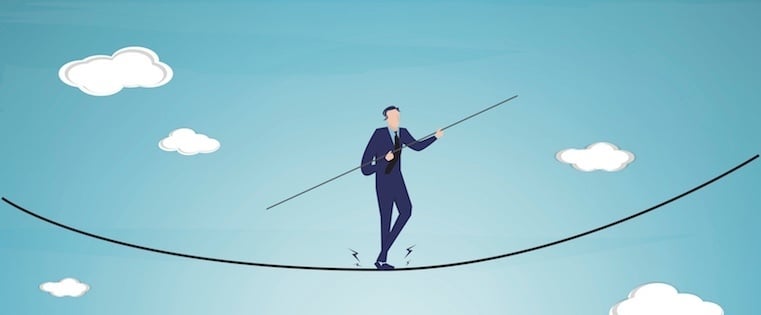On average, salespeople who send at least one follow-up email after no response reach a 27% reply rate. Those who don’t send one get stuck at a 16% average reply rate.
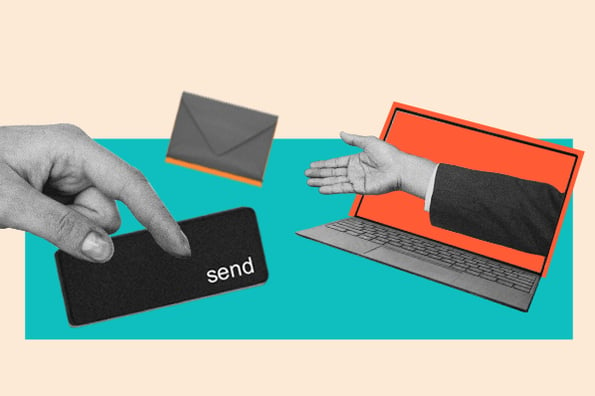
You don’t want that 11-point gap to cost you a major contract or prevent you from exceeding quota. In this post, I’ll show you how to send a follow-up email after no response — and get that prospect to close at last.
In this post, we’ll explore:
- Why send a follow-up email after no response?
- How to Write a Follow-Up Email After No Response
- Second Follow-Up Email After No Response
- Tips for Sending a Follow-Up Email After No Response
- Follow-Up Email After No Response: Mistakes to Avoid
- Follow-Up Email After No Response Example
- Templates for Follow-Up Emails After No Response
.png)
30 Free Follow-Up Email Templates
Follow up with colleagues, sales prospects, recruiters, and networking connections. Great for...
-
Sales Prospects
-
Job Recruiters
-
Networking Connections
-
Workplace Colleagues
Why send a follow-up email after no response?
It’s simple: Following up is critical because it significantly increases your chances of getting a response.
How many times has a deal been going along without a hitch until, suddenly, it’s not? One week of silence passes, then two, and you’re left wondering what you did wrong and if there’s any way to fix it.
By this point, you’ve likely sent previous follow-up emails or left voicemails in your prospect’s inbox. Even if the situation looks bleak, it’s important to continue following up after no response.
Research shows that if you add just one more follow-up email, you can increase your average reply rate by 11 percentage points. Those 11 percentage points may look small, but they’re the difference between a yes and a no.
Follow-up emails also have a higher reply rate in general. The first follow-up email has a 40%-increase in reply rate in comparison to the first email. For instance, if your average reply rate for your first email is 5%, your follow-up email will have an average reply rate of 7%.
So don’t ever skip following up — it can cost you a closed-won deal.
When to Follow Up After No Response
At most, wait three days before following up after no response.
If you wait a week, it’ll be too long. And if you send an email on the same day, you’ll appear desperate. Send two to three emails in your sequence, and remember: never send a breakup email. Instead, leave the conversation open and return to it at a later date.
How to Write a Follow-Up Email After No Response
- Don’t follow up too quickly.
- Ask yourself if you included a close in your first attempt.
- Resist the urge to re-send your first email.
- Write a truthful subject line.
- Start the message with a reminder of your last touchpoint.
- Resist the temptation to be passive-aggressive in your opening.
- Keep the body of the email as short as possible.
- Include a call-to-action at the end.
If your prospect doesn’t respond to your first email, you might be thinking to yourself, “Well, if they didn’t respond the first time, then surely they’re not interested in the product and I should leave them alone.”
Wrong.
Many factors affect a prospect’s decision to not respond to your email. It may not have been the right time; they may have seen it but forgotten to reply; your email got buried in their inbox; they may not be interested now, but if you stay in contact, they’ll be interested later.
There are too many reasons for following up. So, what’s your next step? Here are several principles to adhere to when sending a follow-up email after no response. Follow them, and you’re more likely to welcome a few of those prodigal prospects back into your open arms.
1. Don’t follow up too quickly.
Salespeople like to categorize themselves as persistent, but when following up, persistence can begin to look a lot like pestering.
Being persistent without insight into why the prospect isn’t responding is not smart. If you’re only waiting a day or two to touch base again after the first outreach email, you’re not giving them time to respond.
Worse, it signals to your prospect you’re not that busy — and no one wants to work with a desperate salesperson. Wait at least three days between your first and second follow-up attempts. Then and only then should you accelerate your outreach cadence.
2. Ask yourself if you included a close in your first attempt.
Next, ask yourself if you included a close in your first attempt. It’s easy to soften an initial follow-up email with phrases like “I’d love to hear back from you” or “I’d like to learn more about what you do.”
The problem is, these aren’t questions and none of them ask for a close. Closing isn’t just a will-they-or-won’t-they-sign-the-contract question. Every communication you have with a prospect — from first outreach to final paperwork — should include a close.
Whether you’re closing for another five minutes of their time, a demo, or a discovery call, you’d better have a purpose and call-to-action (CTA) every time you contact your prospect.
So, instead of an ambiguous statement like, “I think I can really help you. I hope we can catch up soon,” make sure you give your prospect an opening to respond. Include firm questions like, “Are you free for a demo this Friday?” or “Can you return all feedback on the initial proposal by next Tuesday?” and give your prospect an actionable request to respond to.
3. Resist the urge to re-send your first email.
Never cut and paste or forward the original email. It might feel empowering, but all it’s doing is advertising to your prospect that you’re making them feel guilty for not responding. From a practical standpoint, this leaves your emails vulnerable to being filtered by spam or blocked entirely.
Treat each follow-up email as a blank slate. Try new subject lines, opening greetings, and CTAs. You never know what’s going to finally move your prospect to respond — so why limit yourself to one email thread that already has nine obsolete messages weighing it down?
.png)
30 Free Follow-Up Email Templates
Follow up with colleagues, sales prospects, recruiters, and networking connections. Great for...
-
Sales Prospects
-
Job Recruiters
-
Networking Connections
-
Workplace Colleagues
4. Write a truthful subject line.
You might be tempted to “embellish” your subject line, but trust me when I say: Don’t. Using subject lines like, “Re: Our meeting last week,” or “Following up on our phone call,” when you’ve never completed either of those actions with the prospect, is lying and always a bad idea.
Don’t try to trick your prospect into opening your emails and responding to them out of confusion. Keep your subject lines positive, clear, and concise. Consider using something like:
- “Bumping this in your inbox”: This lets them know that you’ve sent an email before and are sending another message just in case they missed the first message.
- “Resources list for [business name]”: Another great option that makes your prospect curious about what they might find inside.
- “Following up after the demo last week”: An easy choice if you’ve already carried out a demo with the prospect.
Looking for more ideas? Check out these email subject lines and download more for free below.
Featured Resource: 100 Email Subject Lines We Actually Clicked
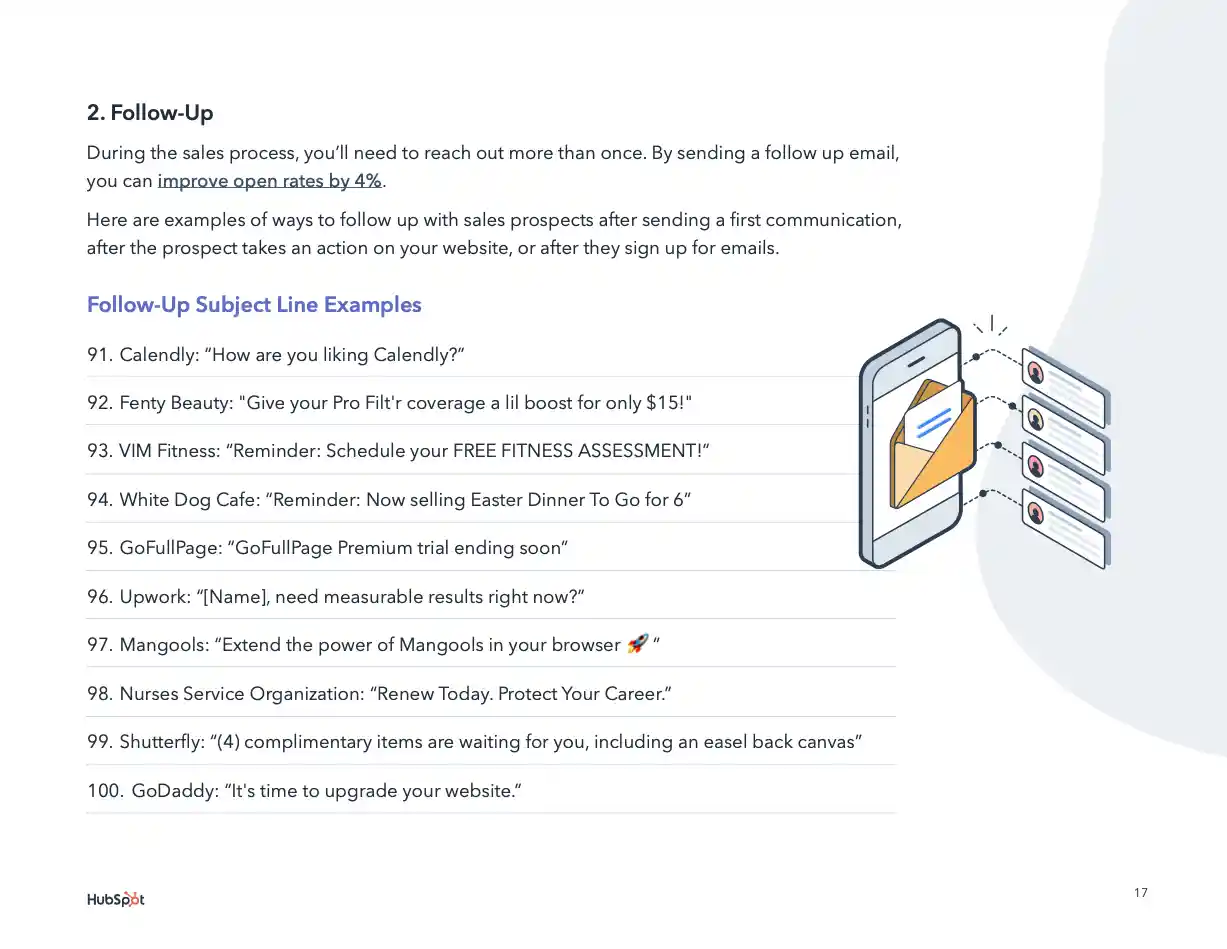
Download Your Free Subject Lines Now
5. Start the message with a reminder of your last touchpoint.
Just as lying to your prospect is in poor taste, so is sending a second email without making it clear you’ve been in contact before. This might work if you’re particularly close with the prospect — say, if you’re childhood friends. (Unlikely, but that might be the case.)
Most likely, you and your prospect don’t interact often enough for them to remember you. Or they might remember you but need a reminder of why you’re reaching out again. And it doesn’t have to be something as explicit as, “This is a follow-up to an email I sent you last week,” or as impersonal as, “I’m contacting you again after attempting to connect with you a few days ago.”
These types of sentences can feel wooden and even accusing. They make it seem like the prospect willfully ignored your email. Maybe they did, but that can be for various reasons, including being busy when they first opened it.
Try simple, straightforward reminders that make you sound friendly and willing to offer more value. Your opening should also get to the point quickly, reminding your prospect of the call-to-action you gave them in your previous message. Here are some examples:
- “Hope you’re well. Did you have a chance to look at the [articles, resources, links] I sent last week?”
- “I hope you’re having a great week. Did you get a chance to look over the contract I sent on [date]?”
- "Hope you’re enjoying the product samples so far. I shot you an email last week to get your temperature on the samples and am bumping this up to the top of your inbox."
6. Resist the temptation to be passive-aggressive in your opening.
When you’ve sent one or two emails and haven’t heard back, it’s easy to start to take it personally. But you have to have thicker skin than that. Lines like, “I’ve tried to reach you a few times now,” or “I know you’re busy, I’m busy too,” do nothing to move your deal forward.
Best case scenario, you guilt your prospect into responding to your message. Worst case, you offend and alienate them. If you email a few times and don’t hear back, keep your tone positive.
When in doubt, assume positive intent. Phrases like, “Just wanted to bump this email to the top of your inbox,” or “Wanted to touch base on this,” quietly acknowledge your prospect is busy and might just need a gentle nudge to get the ball rolling again.
7. Keep the body of the email as short as possible.
A follow-up email shouldn’t contain more than a few bullet points or paragraphs. Stick to three paragraphs at most because, remember — your prospect already got your first email. Your second email should complement the first, not overwhelm your prospect with more information that will make it harder to respond.
The body of your follow-up email should:
- Offer more value to the prospect.
- Clarify how the prospect will benefit if they continue to engage with you.
- Make it irresistible to answer your call-to-action.
On that note, let’s talk about CTAs.
8. Include a call-to-action at the end.
Your prospect should never walk away from one of your emails without knowing what they’re supposed to do. Tell them what you want from them, and you’re more likely to get it. Do you want them to answer a specific question? Give you more information about their company? Forward you to the right person who’d be able to handle the deal?
One thing to note: The CTA should never be the same as the one in your first email. Your prospect likely already saw the first email, and maybe they found the CTA too much for them at the time. Increase your chances of a response by adjusting your close.
I’ll go over that in more detail in the next section, because this will come into play if you need to send a second email after no response.
.png)
30 Free Follow-Up Email Templates
Follow up with colleagues, sales prospects, recruiters, and networking connections. Great for...
-
Sales Prospects
-
Job Recruiters
-
Networking Connections
-
Workplace Colleagues
Second Follow-Up Email After No Response
When sending a second follow-up email after no response, you must think about timing first. Wait three days before getting in touch again, and always send a fresh message. Last, include a call-to-action that shows your prospect what you want them to do next.
You should keep in mind the following important tips if you need to follow up a second time:
Adjust your close every time you don’t get a response.
If you need to follow up a second time and you’re still not getting a response, you might simply be suffering from the wrong call-to-action. Each time you follow up with a prospect after no response, your close should get easier to deliver on (because with each email that goes unanswered, it gets easier for your prospect to ignore you).
If your first follow-up email asked for a meeting, your second might ask for a referral instead. If you still get no response, your third email should request more general information. For example, you might ask, “I’m trying to navigate your organization right now. Where’s the best place for me to go to learn more about Team X and Project Y?”
If all else fails, ask a question entirely disconnected from work. If a new putting range opened in their town, ask, “I saw you have a new Topgolf open in your neighborhood! Have you checked it out yet?”
At times, it’s easier for prospects to answer personal questions about themselves. It reminds them you’re a human and not just a sales machine. Once you get a response to your Topgolf question, steer the conversation back to business.
Don’t send a breakup email.
Never send a breakup email. If you’ve tried these steps, stop sending your prospect emails. Go away, wait, and follow up a few months later.
There’s an old sales adage warning reps not to announce intent. If you send a frustrated email after your fourth follow-up saying, “Well, since I haven’t heard from you, I’ll assume you’re not interested,” you’ve made your prospect feel bad, made yourself look like a victim and decreased the likelihood of them contacting you in the future.
By not saying anything and emailing again after a few months, you’ve kept yourself in a position of authority and avoided passive-aggressively blaming your prospect for never responding.
Follow up with a friendly, “I hope you had a great summer! I know a lot of clients are focused on [benefit your product/service offers] heading into the fall months. Is this a priority for your company right now?”
Tips for Sending a Follow-up Email After No Response
This short list of tips can help you quickly scan your follow-up email to make sure it hits all the right notes with your prospect.
-1.webp)
Choose the right timing.
Timing is key when sending a follow-up email. You shouldn’t send an email one day and then follow up the next day. Give it time.
Daniel Merrill, Founder of Sales and Marketing Oncourse CRM, has found that “Waiting about 48-72 hours strikes the perfect balance — it’s long enough to give your prospect time to respond, yet it keeps the conversation timely and relevant.”
While I prefer to wait for about 3-4 days after my initial email, Daniel’s sentiment is one I agree with wholeheartedly. Waiting for a few days gives the recipient enough time to process your previous email and attend to other priorities.
If the matter is urgent or if you know the recipient’s schedule is tight, adjust your timing accordingly.
Provide more information.
It’s possible that the recipient of your initial email didn’t reply because you didn’t include enough information in your email for them to decide on a response. So, when you’re following up, it can be helpful to offer more context or clarify your needs to remind the prospect about why your original email was important.
I also like to ask a coworker to scan my email and pinpoint parts of it that could be clearer or more direct.
Offer value.
If you can give something valuable, like a free trial or useful content, you’re more likely to get a response to your follow-up email.
Timothy J. Williams, Principal Consultant at Thinksia, knows this all too well. “In my experience in marketing strategy and brand activation, a standout follow-up email tactic involves offering a new, insight-filled piece of content that adds significant value beyond the initial communication,” Timothy explains.
“For example, if the first email introduced our service offerings, the follow-up might contain a case study or a white paper relevant to the prospect’s industry challenges, showcasing our expertise and the tangible benefits of engaging with us. This approach has consistently helped in re-engaging prospects by giving them a reason to reconsider our value proposition.”
If you use this tact, be sure to think about value from the perspective of your contact. For example, an ebook about a problem they’re experiencing might have value, but if they’re too busy to use it, that same content might feel like spam.
In this case, a link to a useful social media post from someone you respect on that topic might be a better way to engage your contact.
.png)
30 Free Follow-Up Email Templates
Follow up with colleagues, sales prospects, recruiters, and networking connections. Great for...
-
Sales Prospects
-
Job Recruiters
-
Networking Connections
-
Workplace Colleagues
Show empathy.
In the example above, the best way to engage your recipient is to consider their perspective and situation. I have personally found that empathy can help build connections and encourage a response.
It takes practice to quickly understand where a new lead or prospect is coming from. This guide to active listening in sales can speed up the process.
Create urgency.
You may not get a quick response to an email because it doesn’t offer a reason for immediate action. To create a sense of urgency, set a deadline or add a time-sensitive offer to encourage them to respond. These questions may inspire you as you craft that sense of urgency in your follow-up email.
Offer social proof.
Social proof such as customer testimonials or case studies can make it easier for prospects to see the value of your product or service.
“Whether it is a customer review on the company’s website, a star rating, or a real case study, this content creates positive feedback from real users,” says Giuseppe Conti, professor of negotiation and influencing.
The stories, images, and tone of social proof can also open paths to new conversations. This is useful because some customers need more time to make decisions and it can be tough to keep them engaged.
Get to the point.
Your follow-up email should be concise, focusing on the essentials without being overly verbose. Your prospect should be able to quickly understand the purpose of your email, so stick to one main topic or question and avoid introducing new, unrelated requests or information, which can overwhelm the recipient or distract from your main purpose.
Scott Gabdullin, CEO and Founder of Authority Factors, put it best: “People get busy; emails get buried. A friendly reminder can make all the difference. Keep it short and sweet. No one wants to wade through a novel in their inbox. Briefly re-introduce yourself and the value you offer, then suggest a next step. Offer something new.
“Did you just publish a relevant blog post? Mention it! Make it easy to respond. End with a clear call-to-action, like a quick call or a link to schedule a meeting. The goal is to jog their memory and show you’re still interested in helping them achieve their goals.”
Express willingness to accommodate.
People are busy — that includes your prospects, too, so demonstrate your flexibility in your follow-up. You might offer to provide further information, adjust timelines, or accommodate your prospect’s schedule. This shows that you respect their time and workload, which can make them more receptive to your request.
Show your credibility.
There’s a higher chance that you’ll get a response if you prove your credibility. Your knowledge and expertise in your industry are clear to you and your colleagues, but they might be new to your customers.
Therefore, add links, content, or stories to your follow-up emails that show why your insights have value. Showing what you know and how it can be useful can help you build trust with your prospect.
Follow-Up Email After No Response: Mistakes to Avoid
.webp)
The biggest mistake is not following up at all. And surprisingly, 48% of salespeople make that mistake. But even if sending a follow-up email puts you ahead of almost half your peers, it’s important to make your message the best it can be by avoiding these common mistakes.
Missing Personal Touches
Without a little personalization, your email will seem self-serving and detached. If you’re looking for a positive response, find ways to make your follow-up email feel engaging, conversational, and useful.
If you’re not sure where to start, do a little research on your prospect with LinkedIn.
Skipping Important Information
If your follow-up email doesn’t include valuable or practical information, your prospect may see it as a waste of time.
Be sure to take careful notes during every call and meeting. Then refer to those notes, as well as past emails, while writing your follow-ups to be sure that each email has some value to the person you’re sending it to.
Forgetting to Proofread
Grammar and spelling aren’t the only mistakes that can make your follow-up email feel unprofessional or careless. Sending emails to the wrong contact or skipping attachments can also be an issue.
So, don’t just rely on your email proofreading tools to check your emails. Confirm sender, subject, and attachment info before clicking send.
Not Adding a Call-to-Action
If you don’t add a CTA, your prospect may not feel a need to respond. A well-written CTA gives your prospect a reason to connect, even if they’re waiting for stakeholders or are not ready to buy.
Check out this list if you’re looking for new call-to-action ideas.
Sounding Pushy or Aggressive
Check the tone of voice in your follow-up emails. Being persistent and direct is motivational. But if you push those qualities too far, they can come off as blunt, harsh, and aggressive.
Don’t hit send without reading your message aloud. As you read, listen for phrases that may put off your recipient.
Not Saying Thank You
Your prospects are busy and want respect for their time. Taking the time to show genuine gratitude can help you build a positive relationship with each follow-up.
.png)
30 Free Follow-Up Email Templates
Follow up with colleagues, sales prospects, recruiters, and networking connections. Great for...
-
Sales Prospects
-
Job Recruiters
-
Networking Connections
-
Workplace Colleagues
Follow-Up Email Example
Below is a great follow-up email template I’ve used in the past.
Bumping this in your inbox
Hello [prospect name],
Hope your week is going well. It was great to hear about your [business pain point] on our last call. I think [company name] can help you [insert benefit].
I'd love the opportunity to tell you a few of my ideas over a 15-minute call. Are you free this Thursday? If so, feel free to book some time on my calendar: [insert calendar link].
Thanks,
[Signature]
If that one doesn’t fit your situation, I’ve drafted several more examples.
Follow-Up Email Templates
Download the Free Follow-Up Templates
We’ve packaged 30 follow-up email templates for you to use in any situation, including:
- General follow-ups.
- Syncing with recruiters.
- Touching base with sales prospects.
- Reconnecting with networking contacts.
Download the templates now and customize them to send the perfect follow-up email. After you’re done downloading your free templates, come back and check out the ones below.
Additionally, with tools like the Email Template Builder, you can further enhance your email communication efficiency and effectiveness. With customizable templates at your fingertips, you can save time and ensure consistency in your communication while still delivering personalized messages. Once downloaded, feel free to tailor the templates to your specific needs and preferences, ensuring your follow-up emails resonate with your audience and drive meaningful engagement.
1. Following Up After Sending Resources
If you sent a list of resources and the customer hasn’t responded, use the below email template. You might have even seen that they opened the email on your CRM, but they didn’t get back to you. In that case, they’re likely too busy to respond.
Resources list for [business name]
Hi [prospect name],
Hope you’re well. Did you have a chance to look at the [articles, resources, links] I sent last week?
Since it was a pretty long list, I’ve compiled the most useful ones below:
- [Link 1]: This is a great how-to on resolving [business pain point] — very quick read.
- [Link 2]: You were curious about [insert product feature], and this is a great summary written by my colleagues.
I’d love to touch base this week and see if we can help [business name] [achieve X results]. Are you free on Friday for a ten-minute call?
Thanks,
[Signature]
Pro tip: If they didn’t respond to your first resource email, whittle it down to just one or two particularly specific resources that connect to their pain points and needs.
2. Following Up After A Meeting
Say you’ve made a sales pitch to a prospect, had a nice conversation with them about your product, and felt confident that they’d ask for a demo or a free trial. A few days later, however, you hear nothing back from them.
In this case, you can send a gentle follow-up email asking if the prospect wants to have a further conversation about the product, book a demo, or try the product out for free. You can also send them a document that summarizes all the details you discussed during your initial meeting to jog their memories.
Ready to Explore [Your Product/Service] Further?
Hi [prospect name],
I hope you’re well! Thank you again for the insightful conversation we had last [day of the week] about how [Your Product/Service] can support the needs of [Their Company Name]. I’ve attached a summary of what we discussed to refresh your memory and help further illustrate the benefits we can offer.
I understand how busy things can get, but I wouldn’t want you to miss out on the opportunity to see our solution in action. Are you available for a demo, or would you like to start with a free trial, as we discussed? I’m here to assist with any questions you might have. I can schedule the demo at your convenience.
Looking forward to helping [Their Company Name] achieve [specific goal discussed in the meeting].
Best regards,
[Signature]
Pro tip: Keep your tone positive and supportive, providing a gentle nudge by reiterating the potential value of your product or service and offering clear next steps to encourage further engagement.
3. Following Up After Demo
Most customers who’ve gotten to the demo stage won’t ignore your emails. They’re likely interested in purchasing your product or service. But if there’s a customer who received a demo and then stopped responding to your emails, it’s useful to touch base again and make sure you’re still on their radar.
Following up after the demo last week
Hello [prospect name],
Just bumping this up in your inbox. Did you get a chance to speak to [higher-up] about moving forward with [product or service]?
If not, I’d love to set up a phone call so I can get your team started [achieving X results]. Are you and your manager available on Wednesday morning for a brief phone call?
Thanks,
[Signature]
Pro tip: Refer to the last call-to-action you established, then offer an alternative that may be more workable.
4. Following Up After a Missed Call
Have you sent an email and also called? And neither of those has gotten a response?
First, this is one of those situations where you’d wait a week. You don’t want to pester the prospect too much. Second, send an email that re-establishes the value you can bring to their company.
Growth opportunities for [business name]
Hey [prospect name],
It seems like it’s not a great time for us to connect, but I really think [specific features] could help your business [achieve X results].
If you’re not the right person to talk to, whom should I reach out to?
Thanks,
[Signature]
Pro tip: If you’ve tried to get in contact several times and get no response, it’s safe to assume they’re not the right person to talk to — or they’re an unqualified lead. Either ask for another contact, or stop emailing the person and wait for the company to hire the right contact.
.png)
30 Free Follow-Up Email Templates
Follow up with colleagues, sales prospects, recruiters, and networking connections. Great for...
-
Sales Prospects
-
Job Recruiters
-
Networking Connections
-
Workplace Colleagues
5. Following Up After A Trigger Event
If you use sales tools to track visitor and lead activity, you’ll get a notification when a prospect performs a trigger event, such as visiting a particular page on your website or reopening your last email. A trigger event is an activity that opens up a sales or marketing opportunity and lets you know which prospects need your product and when to contact them.
When this happens, you can send an email letting the prospect know that you noticed they were checking out something on your site (or whatever the trigger event was) and that you’d like to help them find what they need.
Saw You Checking Out [Specific Page/Product]!
Hi [prospect name],
I noticed you were looking at [specific page or product] on our site recently, and I wanted to reach out to make sure you found everything you were looking for. We believe [Product/Service] could be a great fit for [Their Company Name], especially in areas like [specific benefit relevant to their interest].
If you have any questions or would like more detailed information, I’m here to help! Also, if it sounds useful, I’d be happy to arrange a quick call to discuss how we can meet your needs with [Product/Service].
Looking forward to assisting you further!
Best regards,
[Signature]
Pro tip: Ensure that your follow-up email is friendly, targeted, and personalized, highlighting the prospect’s recent activity and directly addressing their potential needs or interests.
6. Following Up After Sending a Contract
For smaller or freelance businesses, sending a contract is something you do early on in the sales cycle — more like a quote than a legally binding document.
If you’re in enterprise sales, sending a contract is a much bigger deal. It’s implied that the recipient is ready to sign at that point, so you probably won’t need to follow up.
Still, if you didn’t get a response after sending a contract over email, send a short check-in message.
[Product name] contract
Hey [prospect name],
I hope you’re having a great week. Did you get a chance to look over the contract I sent on [date]?
Can I answer any questions or resolve any concerns? I’m excited to get you and your team on board so we can [achieve X results] for your business.
Thanks,
[Signature]
Pro tip: You’ve gotten to the contract stage because you’ve effectively created a connection. Use emotions — positive emotions — to amp up their enthusiasm.
7. Following Up After They Submitted a Sales Inquiry
Your prospect may have submitted a form, signaling purchasing intent. You responded, but they didn’t get back to you.
This lead is still hot, and it’s most definitely worth following up.
Helping your business [achieve X]
Hi [prospect name],
Thanks for reaching out through our website. I realize my last email may have gotten lost in the slush pile, so I’m following up again.
You said you’re interested in [product or service] and are having trouble with [business pain points]. I’d like to set up some time for us to chat. Are you available on Friday morning?
If not, feel free to book a slot on my calendar: [meeting link]
Thanks,
[Signature]
Pro tip: Repeat their pain points, reminding them why they reached out and why they need your product.
8. Following Up After You Connected on Social Media
If you connected on social media, sent an email, and received no response, follow up again — especially if the prospect seemed interested in your offering.
Glad to connect with you on [social media platform]
Hey [prospect name],
It was great to connect with you on [social media platform] last week. I’m touching base again with a few resources that I think would be helpful as your business tries to [achieve X result].
- [Link 1]
- [Link 2]
- [Link 3]
If this isn’t a good time for us to connect, I’d love for us to stay in contact. Submit this form [link] so you can be the first to learn about our product updates straight from me. I’ll be looking out for your submission.
Thanks,
[Signature]
Pro tip: If your first email didn’t get a response, give more value than you did in your first email, and don’t forget to include a call-to-action.
9. Following Up After Prospect Attends Your Webinar
Hosting webinars is a great way to attract people who are interested in your product or service. After hosting a successful webinar, it’s a good idea to follow up with your attendees, build a connection with them, and offer them even more value. Because they’ve already derived value from your webinar, they’ll be more receptive to your emails.
Thanks for Joining Our Webinar on [Webinar Topic]!
Hi [prospect name],
Thank you for attending our recent webinar on [Webinar Topic]. I hope you found it insightful and beneficial. We covered a lot of ground, including [mention any key points or highlights briefly].
To help you further explore the ideas we discussed, I’ve attached some additional resources that I think you’ll find valuable. Also, if you have any questions or would like a deeper discussion on how [Your Product/Service] can specifically help [specific benefit or solution related to the webinar topic], I would be more than happy to set up a follow-up call.
We’re excited to assist you in [specific goal or outcome related to the webinar]. Let’s make sure you have all the support you need to succeed!
Looking forward to hearing from you soon.
Best regards,
[Signature]
Pro tip: In your email, express gratitude, reinforce the value you provided through your webinar, and invite further engagement to build a strong relationship with your prospects.
10. Following Up After Networking Event
One thing I love about networking events is that I get to meet with people I’d love to do business with. However, I’ve found that many of them don’t reach out to you after the event, even though you exchange business cards or contact information.
This is common with virtually all networking events. If you attend one and exchange contact info with people who fit your ideal customer profile (ICP) or who you’d like to collaborate with, but you don’t hear back from them, don’t fret. There are many reasons why this happens: they may have gotten preoccupied with other things, misplaced your contact card, or even forgotten about you entirely.
In cases like these, you can send a follow-up email to them reminding them who you are, how (and where) you met them, and how you’d like to do business with them.
If you want to collaborate with them:
Great meeting you at [Event Name]!
Hi [prospect name],
I hope this message finds you well. It was a pleasure meeting you at [Event Name] last [day of the week]. I really enjoyed our conversation about [specific topic you discussed] and found your insights on [relevant topic] particularly enlightening.
I'm very interested in exploring ways we could collaborate and would love to hear more about your projects at [Their Company Name]. If you’re available, could we schedule a time to chat more about this? I’m flexible with timings and can adjust to fit your schedule.
Thank you for considering this, and I look forward to the possibility of working together.
Warm regards,
[Signature]
If they match your ideal customer profile:
Discovering New Opportunities with [Your Product/Service]
Hi [prospect name],
I hope you’re doing well since our last encounter at [Event Name]! It was a pleasure meeting you last [day of the week] and discussing your current challenges and initiatives at [Their Company Name]. Based on our conversation, I believe that [Your Product/Service] could offer significant value in addressing some of the challenges you mentioned.
I would love the opportunity to give you a brief walkthrough of how our solution can specifically help your team at [Their Company Name]. Are you available for a quick call next week? I can work around your schedule and ensure it’s convenient for you.
Looking forward to the opportunity to assist [Their Company Name] in achieving its goals with [specific benefit of your product/service].
Best regards,
[Signature]
Pro tip: Keep your tone warm and professional, remind the recipient of your previous interaction, and clearly state the purpose of your follow-up. Adjust the specifics and context of your meeting to fit your conversation better and make it more personal.
11. Following Up After They Don’t Renew Their Contract
Some prospects choose to ghost when it’s time to renew their contract, ignoring your first email and even automated reminders from the system.
[Business’] contract up for renewal
Hey [prospect name],
It’s [your name] from [your company name]. Hope you’re having a great week.
Did you receive my email about your contract being up for renewal? Just in case, I’m bumping this up in your inbox.
Your contract’s renewal date was on [date], and the grace period is about to end.
I’d love to talk about alternative options. Are you available on Thursday morning for a fifteen-minute call?
Thanks,
[Signature]
Pro tip: The prospect may not be ready to renew because of a budget or internal issue. Close with a request for a call so you can pitch alternative options, such as an adjusted package.
12. Following Up After Sending a Quote
Typically, you send a quote over email, and if you receive no response, it’s critical to follow up so that you can re-emphasize the efficacy of your solution.
Quote for [product]
Hi [prospect name],
Hope your week is going well. Did you get a chance to look over the quote I sent on [date]?
The sooner I get the quote approved, the sooner we can get your business to [achieve X results].
I’d be happy to answer any questions, and if you need to renegotiate some of the terms, we can hop on a phone call. Would Friday work for you?
Thanks,
[Signature]
Pro tip: Like in the last example, the prospect may be encountering an unexpected internal hold-up. Offer them the opportunity to talk through some of the terms and fees and be open to negotiation.
13. Following Up After Sending Product Samples
In some industries, such as the print and manufacturing industries, product samples are required before the prospect can move forward with a quote, contract, or purchase.
Always follow up if they didn’t respond to your first email — especially if they’re an enterprise customer.
[Your company name] product samples
Hi [prospect name],
Hope you’re enjoying the product samples so far. I shot you an email last week to get your temperature on the samples and am bumping this up to the top of your inbox.
How are the samples working for you? I’ve compiled a comparison chart for the products I sent over:
[link]
I would recommend [product] because of its [feature that relates to their business challenge].
Are you curious about any additional products?
Thanks,
[Signature]
Pro tip: If they’re not responding after receiving the samples, the products may not be a good fit. Offer an opening for them to ask for more samples.
14. Following Up After a Free Trial
A free trial is a great opportunity to showcase your company’s SaaS product and capture a prospect’s attention. If the trial period is about to end and your prospect isn’t responding to your emails, it’s time to check in.
About your [product name] free trial
Hey [prospect name],
Hope you’re having a great week! Just reaching out to let you know that your free trial will end on [date].
How are you enjoying the software? Has it helped your business [achieve X results]?
If you need more time before making a choice, that’s totally understandable. Email me back if you’d like a trial extension, and I’ll work with our product team to get you one more week.
In the meantime, I’d love to hear how the product has been working for you. Are you available on Wednesday afternoon for a 15-minute call?
Thanks,
[Signature]
Pro tip: A prospect’s lack of response doesn’t necessarily mean “No.” And if they took a free trial, they’re very much interested in your offering. But they may need more time. Offer an extension if possible, and always try to schedule a call to find out how the trial is going.
15. Following Up After The Prospect Asks You To Follow Up
There have been times when I emailed a key decision-maker at a company I wanted to work for to ask if they were hiring. They’d get back to me saying they weren’t currently hiring, but I should follow up in a couple of months to see if things have changed.
This can happen in marketing, too; prospects may tell you that they’re not in a position to purchase your product right now, but you should email back in a few months. Once a few months are up, send them an email that looks like this:
Revisiting Our Discussion on [Product/Service]
Hi [prospect name],
I hope this message finds you well. A few months ago, we discussed the potential for [Your Product/Service] to assist with [specific need or problem] at [Company Name]. You suggested I reach back out around this time to explore current possibilities.
I’m reaching out to see if now might be a better time to discuss how [Your Product/Service] can benefit [Company Name]. We’ve recently [mention any new updates or features relevant to their needs], which I think could be particularly useful for your team.
Please let me know if you’re available for a quick call to discuss this further. I’m keen to understand your current priorities and explore how we can provide solutions that make sense for you.
Looking forward to your feedback.
Best regards,
[Signature]
Pro tip: Maintain a professional tone, remind the prospect of your previous conversation with them, and respectfully seek an update on their current needs and interest in your product.
16. Following Up After Prospect Goes Silent After Showing Interest
Ghosting, while sad and discouraging, is pretty common in the marketing and sales industries. Sometimes, a prospect might show interest in your product only to go silent suddenly. They might have been caught up with other things, or they might not want to purchase your product or service anymore. Perhaps they found another product that’s better suited for them.
However, since they expressed interest in your product, it’s wise to send a follow-up email to ascertain why they haven’t said anything further and if they’re still interested in purchasing your product.
Hope All is Well - A Quick Check-In
Hi [prospect name],
I hope you’re doing well. I noticed we haven’t spoken since our last conversation about [Product/Service] and wanted to check in to see if you had any more thoughts or questions. I understand priorities can shift quickly, and I’m here to help address any new issues or concerns you might have.
If there’s anything more you need to know about how [Product/Service] can benefit [specific application for their business], I’d be more than happy to provide detailed information or arrange another demonstration at your convenience.
Please let me know if you’re still interested or if your needs have changed. Either way, I appreciate your consideration and hope to hear from you soon.
Best regards,
[Signature]
Pro tip: Take care to be respectful of the recipient’s possible change in circumstances and keep the door open for further communication, whether they choose to continue the conversation or not.
17. Following Up To Find The Right Contact
When I started my career in marketing, sending an email to the wrong person was my forte. I figured, since the person worked at the company, they’ll be in a position to help me, but this isn’t the case at all. People don’t usually respond to a request that they can’t help with.
Sometimes, you may not get a response to your emails (and follow-ups) because you’re talking to the wrong person. If you feel that the person you sent an email to isn’t the right person, ask them in your next follow-up. Mention that if they’re unable to help with your request, they should refer you to the right point of contact.
Quick Request for Assistance
Hi [prospect name],
I hope this message finds you well. I recently reached out about [brief description of initial request], but I’m not sure if I’m connecting with the right person to discuss this.
Could you please direct me to the appropriate contact at [Their Company Name] who handles [specific department or service area related to your request]? If it’s more convenient, feel free to forward this email to them directly.
Thank you for your time and assistance — I really appreciate it!
Best regards,
[Signature]
Pro tip: Be polite and straightforward. Make it clear what you need, while respecting the recipient’s time. This makes it easy for the recipient to either respond directly or forward your request to the appropriate person.
18. Following Up After An Initial Follow-Up
Sometimes, you may send a follow-up email and still not get a response. But this doesn’t mean you should give up. You can send a second follow-up email to remind the person of your initial email, and you might get a response this time. The third time’s the charm, they say!
Just Checking In – [Your Original Subject]
Hi [prospect name],
I hope this note finds you well. I wanted to touch base once more regarding my previous emails about [specific subject or request]. I understand how busy things can get and just wanted to ensure that this didn’t slip through the cracks.
I believe [reiterate the value proposition or relevance of your request to their needs], and I’m keen to hear your thoughts on this. If there’s someone else on your team who I should connect with instead, please let me know, or feel free to forward this email to them.
Thank you for your time, and I look forward to any update you might be able to provide.
Warm regards,
[Signature]
Or you can use this template:
Quick Follow-Up: [Original Subject]
Hi [prospect name],
I hope you’re doing well. I wanted to reach out again as I haven’t yet heard back from you regarding my last message about [brief description of the original subject]. I understand you have a busy schedule, and emails can easily slip through the cracks!
I’m eager to hear your thoughts and discuss how we can move forward with [specific action or decision]. If it’s more convenient for you, I’m also available for a quick call to go over everything in person.
Please let me know if there’s a better time or another person I should contact to help expedite the process. I appreciate your time and am looking forward to your response.
Warm regards,
[Signature]
Pro tip: Keep your tone light and professional, reiterate the reason for your follow-up, and open the door for your email to be directed to someone else if the recipient is not the correct contact.
Always Send a Follow-Up Email After No Response
Salespeople work hard, and receiving answers to our emails makes us feel successful. We don’t want to send too many follow-up emails, but they’re critical for leading the conversation toward a closed-won deal. Test out a few of these tactics in your follow-up outreach and watch as they make a significant difference in your response rates.
Editor's note: This post was originally published in June 2018 and has been updated for comprehensiveness.
.png?width=375&height=375&name=Image%20Hackathon%20%E2%80%93%20Square%20(50).png)
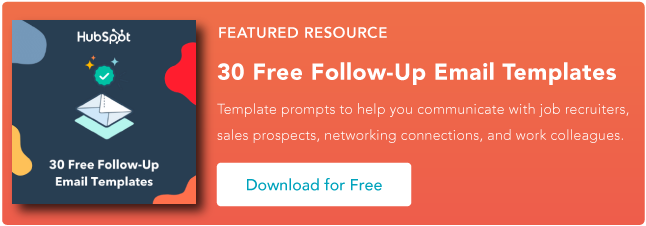
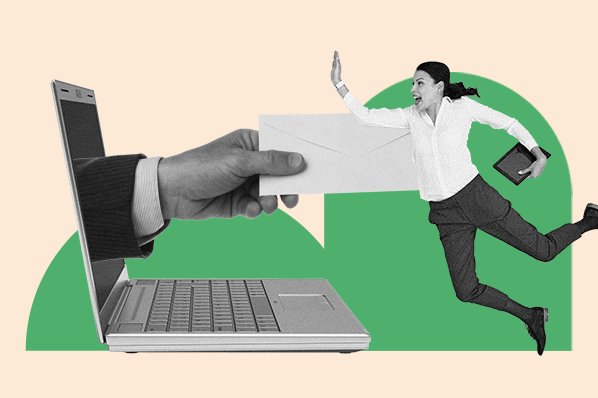



![How to Write a Follow-Up Email After an Interview [Templates + Tips]](https://blog.hubspot.com/hubfs/Follow%20Up%20Email-May-16-2023-03-38-50-7356-PM.png)



